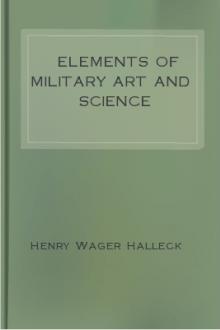Elements of Military Art and Science by Henry Wager Halleck (books you have to read txt) 📕

- Author: Henry Wager Halleck
- Performer: -
Book online «Elements of Military Art and Science by Henry Wager Halleck (books you have to read txt) 📕». Author Henry Wager Halleck
Military communications.—The movements of armies are always much embarrassed by forests, marshes, and water-courses, and nothing contributes more to the dispatch of military operations than the means of opening practical and easy communication through these various obstacles.
It is not necessary here to enter into any detailed discussion of the manner of constructing military communications through forests or marshes. In a new country like ours, where almost every one has had some experience in road-making, no very great technical knowledge is required for the construction of temporary works of this character; but much professional skill and experience will be requisite for the engineers who make the preliminary reconnaissances, and fix the location of these roads.
Water-courses may be crossed by means of fords, on the ice, or by ferries and bridges. When temporary bridges or ferries are constructed by the army in the field, they are classed under the general head of military bridges, or more properly, pontoniering.
Where the depth of the stream is not great, the current slight, and the bottom smooth and hard, the passage may be effected by fording. If the bottom be of mud, or large stones, the passage will be difficult and dangerous, even where the depth and current are favorable. Under favorable circumstances infantry can ford a stream where the depth is not greater than four feet; cavalry to a depth of four or five feet; but artillery, and engineer trains, cannot go to a depth of more than two and a half feet, without greatly exposing their ammunition and military stores The fords should be accurately staked out before the passage is attempted, and ropes ought to be stretched across the stream, or cavalry and small boats stationed below, to prevent the loss of life.
Ice may be crossed by infantry, in small detachments. Its strength may be increased by covering it with boards, or straw, so as to distribute the weight over a greater surface. By sprinkling water over the straw, and allowing it to freeze, the mass may be made still more compact. But large bodies of cavalry, and heavy artillery, cannot venture on the ice unless it be of great thickness and strength. An army can never trust, for any length of time, to either fords or ice; if it did a freshet or a thaw would place it in a most critical state. Military bridges will, therefore, become its only safe reliance for keeping open its communications.
Military bridges are made with trestles, rafts, boats, and other floating bodies. Rope bridges are also sometimes resorted to by troops for passing rivers.
Trestle bridges are principally used for crossing small streams not more than seven or eight feet in depth: they also serve to connect floating bridges with the shore, in shallow water. The form of the trestle is much the same as that of an ordinary carpenter's horse, i.e., a horizontal beam supported by four inclined legs. These trestles are placed in the stream, from twelve to twenty feet apart, and connected by string-pieces, (or balks as they are termed in technical language,) which are covered over with plank. The action of the current against the bridge may be counteracted by anchors and cables, or by means of boxes or baskets attached to the legs of the trestles, and filled with stones. A more substantial form may be given to the bridge by substituting for the trestles, piles, or the ordinary framed supports so much used in the newer parts of our country.
For examples of the use of bridges of this description we would refer to Cæsar's celebrated bridge across the Rhine; the passage of the Scheldt in 1588 by the Spaniards; the passage of the Lech in 1631 by Gustavus Adolphus; the passage of the Danube in 1740 by Marshal Saxe; the great bridge across the Var during Napoleon's Italian campaigns; the passage of the Lech in 1800 by Lecourbe; the bridges across the Piava, the Isonso, &c., in the subsequent operations of the army in Italy; the celebrated passage of the Danube at the island of Lobau in 1809; the passage of the Agueda in 1811 by the English; the passages of the Dwina, the Moscowa, the Dneiper, the Beresina, &c., in the campaign of 1812; the repairing of the bridge near Dresden, and the passage of the Elbe in 1813, &c.
Rafts formed of timbers, casks, barrels, &c., are frequently used as military bridges. They may be made to bear almost any weight, and will answer for the passage of rivers of any depth and width, provided the current be not rapid.
Where the bridge is to be supported by rafts made of solid timbers, these timbers should be first placed in the water, to ascertain their natural position of stability, and then the larger ends cut away on the under side, so as to present the least possible resistance to the action of the current. They are afterwards lashed together by strong rope or withe lashing, or fastened by cross-pieces let into the timbers, and held firm by bolts, or wooden pins. These rafts are kept in place by anchors and cables placed up and down stream. The roadway is formed in nearly the same manner as for a bridge supported on trestles. Empty casks, and other floating bodies, may be substituted in place of logs in the construction of rafts.
For examples of the use of rafts in the construction of military bridges, we would refer to the passage of the Seine in 1465 by Count Charolais; the passage of the Meuse in 1579, by Alexander Farnése; the passage of the Vistula in 1704, the Borysthenese in 1709, and the Sound in 1718, by Charles XII.; the passage of the Adige in 1796; the passage of the Po in 1807; and the subsequent military operations in the Spanish Peninsula.
Military bridges are frequently made of boats, and the ordinary river-craft found in the vicinity of the intended passage. Flat-bottomed boats are the most suitable for this purpose, but if these cannot be obtained, keel boats will serve as a substitute. When these water-craft are of very unequal sizes, (as is frequently the case,) two smaller ones may be lashed together to form a single support; they can be brought to the same level by means of stone ballast. The gunwales must be suitably arranged for supporting the balks, or else frameworks should be erected for this purpose from the centre of the boat. The arrangement of the roadway, anchors, &c., is the same as before.
A bridge-equipage made to follow an army in its movements in the field, is generally composed of light skiffs or batteaux, and the necessary timbers, planks, anchors, &c., for forming the roadway, and keeping the bridge in its position. All these articles are constructed especially for this purpose. All the wood-work should be of tough and well-seasoned timber, so as to impose no unnecessary weight on the wagon trains. The bateaux should also be made of strong and light materials. For convenience in transportation, these boats are sometimes made with hinges so as to fold up. The ribs are usually of oak, and the sides and bottom of pine. Instead of plank, a covering of tin, copper, India-rubber, &c., has sometimes been substituted. Floating supports of this character are often made in compartments, so as to prevent their sinking when injured by the enemy's projectiles. Indian-rubber pontons may be folded up into a small space, and their slight weight renders them convenient for transportation.
On navigable streams a part of the bridge resting on one or two bateaux should be so arranged that it can be shipped out of its place, forming a draw for the passage of river-craft. Indeed, it would be well, even where the river is not navigable, to form a draw for the passage of trees, and other floating bodies, sent down by the enemy against the bridge.
An ordinary bridge-equipage of bateaux, or light pontons, for crossing a river of from three to four hundred yards in width, and of moderate current, will require a train of from sixty to eighty wagons.[46] Under favorable circumstances, and with a well-instructed corps of pontoniers, the bridge may be thrown across the river, and prepared for the passage of an army in a few hours at most.[47] After the troops have passed over, the bridge may be taken up, and replaced on the wagons in from a quarter to half an hour.
[46]
The number of wagons in a ponton train will be greatly diminished if it be found that Indian-rubber boats may be used as supports for the bridge. The engineer department of our army are making experiments to determine this point.
[47]
In 1746, three bridges of bateaux were thrown across the Po, near Placentia, each fifteen hundred feet in length, and entirely completed in eight hours. In 1757, two bridges of bateaux were thrown across the Rhine, at Wesel, in half an hour; again, in the same year, a third bridge was thrown across this river near Dusseldorf, in six hours. In 1841, Col. Birago, of the Austrian army, arrived on the bank of the Weisgerben arm of the Danube, with his bridge-equipage, at a round trot, and immediately began the construction of his bridge, without any previous preparation or examination. In less than three-quarters of an hour the bridge was completed, and three loaded four-horse wagons passed over on a trot, followed by a column of infantry.
The following examples will serve to illustrate the use of different kinds of boat-bridges in military operations:—the passage of the Rhine, in 1702, by Villars; the passage of the Dnieper and the Bog, in 1739, by the Russians; the passage of the Danube, in 1740, by Marshal Saxe; the passage of the Rhine, near Cologne, in 1758, by the Prince of Clermont; the passage of the Rhine, in 1795, by Jourdan; the passage of the Rhine, at Kehl, in 1796, by Moreau; and again the same year, at Weissenthurn, and at Neuwied, by Jourdan; the bridges across the Rhine, at the sieges of Kehl and Huninguen, in 1797; the passage of the Limmat, in 1799, by Massena; the passages of the Mincio, the Adige, the Brenta, the Piava, &c., in 1800; the passages of these rivers again in 1805; the passages of the Narew, in 1807, by the Russians; the several passages of the Danube, in 1809, by the French and Austrian armies; the passages of the Tagus and Douro, in 1810, by the English; the passages of the Niemen, the Dwina, the Moskwa, and the Beresina, in 1812, by the French; and of the great rivers of Germany and France, in





Comments (0)